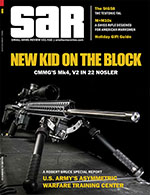Book Review: V21N10
By Dean Roxby
The ArmaLite Story, Finely Researched Tome Chronicle’s AR-10’s Origins
Collector Grade Publications is well known for producing high-quality firearms books, and this title does not disappoint. Author Joseph Evans does a fine job of detailing the history of the AR-10 from the earliest days of ArmaLite, through to its use in actual combat in various hotspots.
From the formation of the company S-F Projects by brothers-in-law George Sullivan and Charles Dorchester in Hollywood, CA, through to its acquisition by Fairchild Engine and Airplane Corporation—not to mention the chance meeting of Eugene Stoner and Sullivan at a local gun range—the history of ArmaLite is well documented.
Sullivan and Dorchester’s pre-ArmaLite design is covered; the S-F Para-Sniper rifle was a bolt-action firearm that employed an aluminum barrel with a stainless-steel liner and a fiberglass stock. This construction was quite revolutionary in the late 40s and early 50s.
Several early prototypes from the fertile mind of Eugene Stoner are also profiled. The M-5, M-6 and M-7 semi-auto rifles each earn several pages. These rifles are fairly traditional in appearance, with a drop-heel wood stock. They did, however, use a rotating bolt and barrel extension, along with an aluminum receiver. Chapter One ends with the Stoner M-8: “the first AR-10.” While it is far removed from the final product, the origins of the AR-10 family can clearly be seen in this prototype.
Chapter Two starts with a description of the various ArmaLite AR-prefix firearms released by the newly formed ArmaLite division of Fairchild. The Para-Sniper bolt action sporting rifle was now known as the AR-1. The AR-5A was a single shot bolt-action survival rifle for USAF aircrew, while the somewhat similar-looking AR-7 Explorer semi-auto .22 rimfire was marketed to civilians. A closer look at the early prototype versions of the AR-10 then follows. The M-8 (Also referred to as the X-01), the X-02 and X-03 (Later named the AR-10A) are detailed. It is interesting to see how the lineage progresses toward what we all recognize as the typical AR-10.
Chapter Three covers the testing of the AR-10B rifles submitted to Springfield Armory in 1956/57. As the book explains, there was blatant scorn for this unorthodox-looking rifle. Not only did it not look how a real wood and steel rifle should, it was also “not invented here.” And so it was that the AR-10B lost out to the M-14 rifle.
Part II, Chapter Five delves into the production models built in the Netherlands by Artillerie-Inrichtingen (A-I). ArmaLite licensed the production rights to A-I, who then attempted to sell the AR-10 worldwide. Although no large contracts were ever secured—usually due to their inability to deliver large orders in little time—they did fill several small trial orders. These contracts often had minor details changed to suit each nation. Consequently, collectors refer to “the Cuban model” and so on. Variants from Cuba, Guatemala, Portugal and Sudan are compared in great detail in the following chapters.
This book covers not only the finer details of the gun itself, but the often complex process involved in choosing a service rifle. Much historical background is given to the selection processes and criteria of various countries in replacing their WWII-era rifles. Often, the AR-10 came out ahead of the rest of the competition only to lose the order. As noted above, A-I did not have the ability to deliver large orders (100,000+) in a timely fashion. When they refused to allow licensed production in Austria or Germany, they lost out to the FN-FAL.
The book is divided into two parts (Part I: The Hollywood Years; and Part II: The “Prime Time” AR-10), 13 chapters and many sub-chapters. Some of these sub-chapters are very short. Several are single run-on sentences. One thing that does stand out is how much the author showers the AR-10 system with glowing praise. The author freely admits this, stating “this author so often lavishes hyperbolic praise on this masterful battle rifle.”
Many technical photos, drawings, patent sketches and examples of promotional advertising from the era are featured. Furthermore, there are numerous images of experimental designs, such as belt-fed versions. Learning about these obscure variants is fascinating. Also covered are some of the characters behind the scenes, such as arms runner Samuel Cummings, one of the more colorful members of ArmaLite’s foreign sales team.
Chapter Eleven looks at the AR-10 in combat, mainly in the Portuguese African territories. Chapter Twelve discusses the collector market. The closing chapter explores the recent resurgence of the Knight’s Armament SR-25. This is an appropriate ending, as both the U.S. Army and Navy have now adopted the SR-25 for sniping duty. The Army calls it the M110 Semi-Auto Sniper System, and the Navy has styled it the Mk 11, Mod 0. Speaking of Knight’s, many of the photos of unique early specimens are from the Institute of Military Technology collection. Also, a brief look is given to the AR-16 prototype and the related AR-18/180 series.
Thoroughly researched, featuring many images of rare variants and presented with the quality that Collector Grade Publications is known for, this title will appeal to anyone interested in the AR-10 battle rifle.
THE ARMALITE AR-10: WORLD’S FINEST BATTLE RIFLE
DELUXE FIRST EDITION, ©2016
AUTHOR: JOSEPH PUTNAM EVANS
PUBLISHER: COLLECTOR GRADE PUBLICATIONS
ISBN: 0-88935-583-5
COPYRIGHT: 2016
PAGES: 416, HARDCOVER, COLOR DUST JACKET, 389 PAGES OF TEXT, PLUS TABLE OF CONTENTS, BIBLIOGRAPHY AND INDEX, 356 ILLUSTRATIONS (MANY IN COLOR)
USD: $79.95
This article first appeared in Small Arms Review V21N10 (December 2017) |
| SUBSCRIBER COMMENT AREA |
Comments have not been generated for this article.




